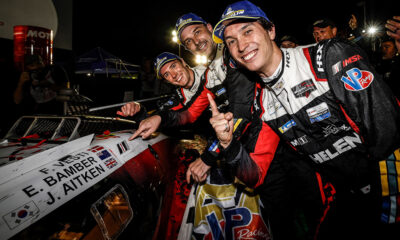
Photo: Mike Levitt/IMSA
With five of the nine GTP class cars on the grid, spread between three teams and two manufacturers, Dallara is the most represented chassis constructor for the kickoff of the new LMDh era at this weekend’s Rolex 24 at Daytona.
From juggling supply chain challenges to working with its two manufacturer partners BMW and Cadillac, the Italian company has one of the largest footprints in the Daytona paddock.
Sportscar365 caught up with Dallara chief technical officer Aldo Costa to get his thoughts on a variety of topics, including its involvement in LMDh, LMP2 and the NASCAR Garage 56 project.
Dallara is involved in all facets of motorsport as well as the auto industry. This must be a busy time for the company…
“Is it a busy time, but as well very very enjoyable. [There are] a lot of programs in parallel going on. What we see here, IMSA racing with Cadillac and with BMW, is only one of the things that we are doing at Dallara at the moment.
“It is really tough, but so far we are quite happy about what the wider group has been able to deliver and to build. So even if it is a very busy time, in this moment we are in a moment of quite calm and focused moment.”
How has Dallara been able to overcome the supply chain challenges impacting all companies?
“That has been a real tough battle. We have been the only one to manage two parallel programs in this category, which is not trivial at all. With three teams at the end.
“A constructor in the end is a collector of all the delays that suppliers are generating. But then the outcome from the constructor has to be, because the race is a fixed date, has to be brought to zero delays or manageable delays.
“That has been really tough, but with a lot of planning activity and a lot of detailed managing and a lot of effort of finding alternative solutions or speeding up each individual program, it has been achievable and possible in the end.”
How do you keep the BMW and Cadillac LMDh programs separate?
“Since the beginning the role of engagement has been quite clear. So there are dedicated people that are working on the two separate programs. All of them, they know that very respectful of all of the intellectual properties of the two OEMs.
“Of course, what is the spine and spine experience in terms of failure analysis and spine development has to be known from the two OEMs and has to be common. So there are people that are working for the two manufacturers, but on the spine.
“We are managing a huge amount of projects. There are very few people that know all of it. The OEMs, they know and they trust our fairness in terms of respecting of the IP, but not only pushing for the same effort with all of the programs in parallel.”
Was it challenging to build a spine that works for both manufacturers?
“We adopted a very open relationship with the OEMs, so we did not impose final solutions. Of course we started with our own spine projects.
“When track time and development on track came, OEMs interpreted the car in a different way and they highlighted possible development.
“And yes, that was the more difficult moment and again treated with fairness and open attitude, we arrived to make a good conclusion in all the items.”
What is Dallara’s position on working with additional manufacturers for LMDh in the future?
“During the development of those two activities, we did not consider having a third one because it would not have been possible for our organization.
“Even now, it is very tough in this moment as you mentioned for the new programs that are coming. But the principle of LMDh is like that and you’ve got the platform that is available for any other OEM.
“A time will arrive where we will consider other OEM and if possible, we will develop. Again, [we’re] very respectful with Cadillac and BMW for their own activity.”
Do you feel there’s interest from other OEMs to join?
“We sense at the moment that the form is very well received and there’s a lot of attention. The concept of having the style on the car, so having a car that is a proper bespoke, OEM-style car is very very important and has built a lot of interest.
“On top of that, OEMs can develop their own technology in terms of power unit and ultimately in terms of track activity, team development on track.
“So it is definitely something very interesting for OEMs, I think. And then joining IMSA with WEC, having the possibility to compete anywhere in the world has been another key of the success of this formula.”
The new LMP2 regulations have been delayed until 2026. Are you in support of that?
“We have been available for starting sooner, but we understand the situation. It has been discussed for quite a long time, but it requires more discussion.
“We need to develop the new formula to make it respectful and sustainable for the environment so we need to apply to LMP2 as well what we see applied on other formulas.”
Dallara developed the NASCAR Next-Gen chassis, which serves as the basis of the Garage 56 effort for Le Mans. How has it been working on the project?
“We are involved in it, in the program with NASCAR. It is another parallel challenge, very interesting and we are looking forward to see the outcome.
“The NASCAR organization is of course fully active on this project and we are supporting the activity and doing some engineering activity on that car and giving our experience of sports cars, GT cars and hypercars in general.”























